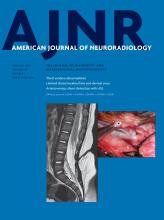Index by author
Yang, E.
- FELLOWS' JOURNAL CLUBPediatric NeuroimagingOpen AccessWhite Matter Injury and General Movements in High-Risk Preterm InfantsC. Peyton, E. Yang, M.E. Msall, L. Adde, R. Støen, T. Fjørtoft, A.F. Bos, C. Einspieler, Y. Zhou, M.D. Schreiber, J.D. Marks and A. DrobyshevskyAmerican Journal of Neuroradiology January 2017, 38 (1) 162-169; DOI: https://doi.org/10.3174/ajnr.A4955
Cerebral palsy has been predicted by analysis of spontaneous movements in the infant termed “General Movement Assessment.” The authors evaluated the utility of General Movement Assessment in predicting adverse cognitive, language, and motor outcomes in very preterm infants and attempted to identify brain imaging markers associated with both adverse outcomes and aberrant general movements in 47 preterm infants using MRI volumetric analysis and DTI. Nine infants had aberrant general movements and were more likely to have adverse neurodevelopmental outcomes, compared with infants with normal movements. In infants with aberrant movements, Tract-Based Spatial Statistics analysis identified significantly lower fractional anisotropy in widespread WM tracts. They conclude that aberrant general movements at 10–15 weeks' postterm are associated with adverse neurodevelopmental outcomes and specific white matter microstructure abnormalities for cognitive, language, and motor delays.
Yang, H.-C.
- NeurointerventionYou have accessQuantifying the Cerebral Hemodynamics of Dural Arteriovenous Fistula in Transverse Sigmoid Sinus Complicated by Sinus Stenosis: A Retrospective Cohort StudyW.-Y. Guo, C.-C.J. Lee, C.-J. Lin, H.-C. Yang, H.-M. Wu, C.-C. Wu, W.-Y. Chung and K.-D. LiuAmerican Journal of Neuroradiology January 2017, 38 (1) 132-138; DOI: https://doi.org/10.3174/ajnr.A4960
Yeatts, S.D.
- FELLOWS' JOURNAL CLUBNeurointerventionOpen AccessEndovascular Therapy of M2 Occlusion in IMS III: Role of M2 Segment Definition and Location on Clinical and Revascularization OutcomesT.A. Tomsick, J. Carrozzella, L. Foster, M.D. Hill, R. von Kummer, M. Goyal, A.M. Demchuk, P. Khatri, Y. Palesch, J.P. Broderick, S.D. Yeatts, D.S. Liebeskind and for the IMS III InvestigatorsAmerican Journal of Neuroradiology January 2017, 38 (1) 84-89; DOI: https://doi.org/10.3174/ajnr.A4979
The authors reviewed the impact of revascularization on clinical outcomes in 83 patients with M2 occlusions in the Interventional Management of Stroke III trial according to specific M1–M2 segment anatomic features. AnmRS 0–2 outcome was associated with reperfusion for M2 trunk (n = 9) or M2 division (n = 42) occlusions, but not for M2 branch occlusions (n = 28). Of the 83 participants with M2 occlusion who underwent endovascular therapy, 41.0% achieved mRS 0–2 at 90 days, including 46.6% with modified TICI 2–3 reperfusion compared with 26.1% with modified TICI 0–1 reperfusion. They conclude that mRS 0–2 at 90 days was dependent on reperfusion for M2 trunk but not for M2 branch occlusions in IMS III.
Yom, S.S.
- Head and Neck ImagingYou have accessImpact of Neuroradiology-Based Peer Review on Head and Neck Radiotherapy Target DelineationS. Braunstein, C.M. Glastonbury, J. Chen, J.M. Quivey and S.S. YomAmerican Journal of Neuroradiology January 2017, 38 (1) 146-153; DOI: https://doi.org/10.3174/ajnr.A4963
Yousem, D.M.
- Adult BrainYou have accessEmergency Department MRI Scanning of Patients with Multiple Sclerosis: Worthwhile or Wasteful?J. Pakpoor, D. Saylor, I. Izbudak, L. Liu, E.M. Mowry and D.M. YousemAmerican Journal of Neuroradiology January 2017, 38 (1) 12-17; DOI: https://doi.org/10.3174/ajnr.A4953
- You have accessSurvey of Head and Neck PracticeD.M. YousemAmerican Journal of Neuroradiology January 2017, 38 (1) E9; DOI: https://doi.org/10.3174/ajnr.A4985
Yousry, T.A.
- EDITOR'S CHOICEAdult BrainOpen AccessHippocampal and Deep Gray Matter Nuclei Atrophy Is Relevant for Explaining Cognitive Impairment in MS: A Multicenter StudyD. Damjanovic, P. Valsasina, M.A. Rocca, M.L. Stromillo, A. Gallo, C. Enzinger, H.E. Hulst, A. Rovira, N. Muhlert, N. De Stefano, A. Bisecco, F. Fazekas, M.J. Arévalo, T.A. Yousry and M. FilippiAmerican Journal of Neuroradiology January 2017, 38 (1) 18-24; DOI: https://doi.org/10.3174/ajnr.A4952
Brain dual-echo, 3D T1-weighted, and double inversion recovery scans were acquired at 3T from 62 patients with relapsing-remitting MS and 65 controls. Focal WM and cortical lesions were identified, and volumetric measures from WM, cortical GM, the hippocampus, and deep GM nuclei were obtained. Compared with those with who were cognitively preserved, patients with MS with cognitive impairment had higher T2 and T1 lesion volumes and a trend toward a higher number of cortical lesions. Significant brain, cortical GM, hippocampal, deep GM nuclei, and WM atrophy was found in patients with MS with cognitive impairment versus those who were cognitively preserved. The authors conclude that hippocampal and deep GM nuclei atrophy are key factors associated with cognitive impairment in MS.








